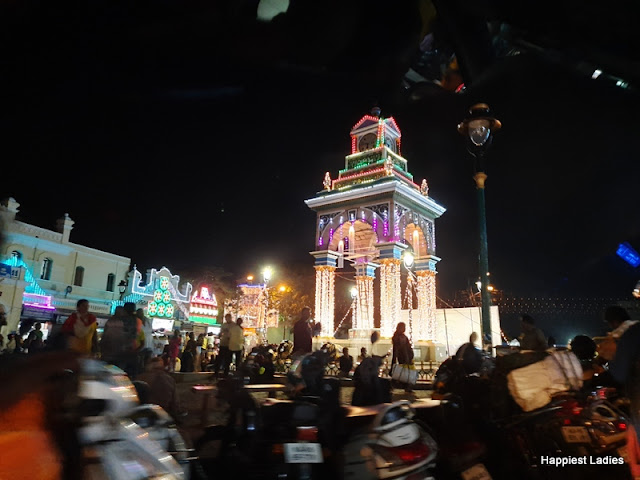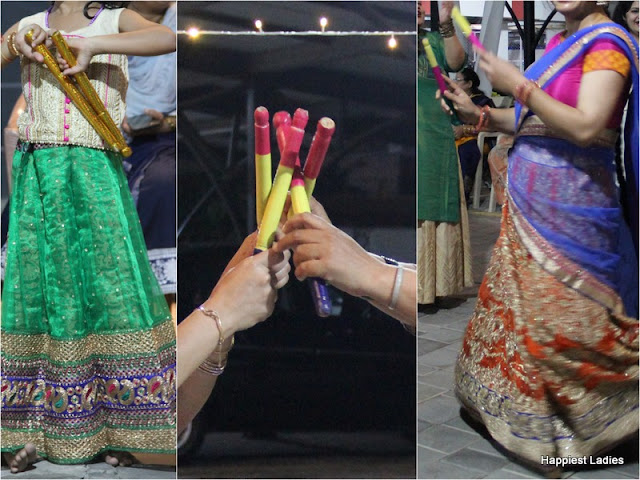Festive Events I Attended This Season 2019 | Festivals of Karnataka | Hindu Festivals in India
Starting with VaraMahalakshmi
Vrutha/Pooja, there are several festivals that are celebrated uniquely at homes
in Karnataka.
The festive season in India is
completely different as is considered globally. The festivities hold special
significance and goes back to Hindu mythologies and puranas.
Vara Mahalakshmi Puja
A devi idol is handmade and
decorated with all possible accessories. Puja is performed by women in most
households. Married women and young girls residing in the neighbourhood are
invited for arasina-kumkuma-prasada.
This is the typical way of sharing
lord’s blessings and wishing prosperity to all.
I hopped from home to home to seek Devi’s
blessings.
Krishna Janmashthami
Krishna is revered as the lord
and protector of this universe. With midnight aarti to welcome the new born
Kanha Ji, and the following day’s energetic celebration of the birth of Lord, this
is a very special festival across India.
Tiny tots are all seen dressed up
as Little Krishna and Radha, it is a sight to behold. Reciting of Krishna
Shlokas and Krishna bhajans collectively is a common practice during this
festival.
Dancing to the tunes of songs
that praises Lord Krishna can be witnessed among the devotees.
Distributing of laddus and other
special festive recipes is the most awaited moment for all as it imparts the
culture of sharing and wishing everyone happiness.
Ganesh Chaturthi
An idol of eco friendly clay
Ganesha and Devi Gauri was installed in our apartment premises and celebrations
reached to great heights.
People sang bhajans and shook
legs during the visarjan procession.
An art’s corner of various
drawings and paintings of Lord Ganesh was displayed. Kids and adults of all age
contributed to this gallery.
Dasara (Navaratri and Vijaya Dashami)
Auspicious nine days of Navratri
that ends with Vijaya Dashami on 10th day is soon followed by
another prominent festival celebrated in India, Diwali.
The entire season is collectively
so very special that most of us plan every possible thing under the sun during
this time of the year.
- Some arrange for Devi puja at home and invite guests for prasadam.
- There are some who arrange Dasara golus – also known as Dasara Gombe. This is special practise in southern parts of India.
Gombe Habba at a friend's place during Dasara season
- Dandiya night with music and dance
- Travel to the famous destination where celebrating Navratri/Dasara has gained worldwide popularity.
Mysore Dasara has become every
year’s affair
Here, I share few special
captures through my lens of this festive season. Mostly, it all covers the
special Dasara events held in Mysore.
Planning a trip to Mysore during
Dasara season is a must for all travel loving people.
Vintage Car Rally Show (Lalith Mahal Palace to Amba Vilas Palace)
Beginning with Vintage Car Rally
Show that started from the premises of Lalit Mahal Palace and reached Amba
Vilas Mysore Palace grounds.
Watch video at the link below
The Flower Show at Kuppanna Park
The Fine Arts and HandiCrafts
Exhibition at Kalamandir
Micro Art on Rice Grain.
Mr. Rice Grain Venkatesh inspiring youngsters to take up this art as hobby.
Rice grain inscribed Mysore Wodeyar photo
Channapatna Wooden Toys, Kinhala Art Furnitures, Bamboo Works
Pot Making and Clay Artefacts
The Food Mela at Scouts and
Guides ground.
Mysore Dasara Ahaara Mela 2019 (Food Festival 2019)
Mysore Palace and City
Illumination
Chikka Gadiyaara lit up during Dasara, in front of Devraj Market, Mysore
The green pandal at Sayyaji Rao Road, #MysuruDasara2019
Chitra santhe, air show and many
more.
Dandiya on the eve of Maha Navami
(9th day of Navratri)
Dressed in great embellished
ghagra cholis, anarkalis and lehengas, the energetic dandiya dance in the big
circle is a great sight to see.
I did attend one in our premises.
The puja and prasad followed by swirling and twirling dance steps.
Ravan Dahan at the grounds of ISKCON-Mysore
on Vijaya Dashami (10th day of victory)
While Mysore Dasara is a grand
state affair in Karnataka, elsewhere in Mysore ISKCON temple also organizes a
totally different kind of Dussehra celebrations. Mysore celebrates the victory
of Devi Chamundi who fought against the demon Mahishasura for nine days and won
on the tenth day i.e. Vijaya Dashami.
In the northern states of India,
Dasara is the victory of Lord Rama in the fierce battle against the demon
Ravana. Depicting the same is the great event of Ravan Dahan at the grounds of
ISKCON Temple, Mysore.
Effigies of Kumbhakarna, Ravan and Meghanad
Ravan Dahan is attended by
thousands of devotees every year. The effigies of the three asuras,
Kumbhakarna, 10 headed Ravana and Meghanad are burnt by series of firecrackers
that soar high up in the air indicating the demolishing of evil and prevailing
of prosperity in the society.
Thousands of devotees waiting to watch Ravan Dahan
Effigies of demons being burnt as a sign of victory over evil;
Firecrackers marking the celebrations
The occasion was graced by
beautiful Bharatnatyam dance performances by artists from Chennai. Every move
was worth watching without fluttering the eyelids even once.
Arpanam, a short extracted story
from Raam Katha in the form of Bharatnatyam was performed in full glory.
Bharatnatyam Dance depicting the story of Sita-Ram and their devotees
A trip to Trichy – Srirangam –
Thanjavur during Navaratri
A trip to a new destination
during festive season gave us an insight of what the destination has got to
offer us during the festival.
Most temples have either Lord
Shiva or Bhagawan Vishnu as presiding deity. Devi Parvita and Lakshmi have
equal importance in these temples. This simple means that Navratri is a
festival that is celebrated with great pomp here.
A golu arrangement during
Navratri at
Goddess Akilandeswari shrine within the
premises of Sri Jambukeswarar Temple, Trichy. It is huge and amazingly done !
Navratri Golu arrangement at
Akilandeswari shrine, Jambukeswarar Temple, Trichy
Sri Ranganayaki
Thayar shrine within Sri Rangatha Swamy Temple in Srirangam is a feast to the
eyes of all devotees during Navratri. The utsava (procession) in the premises
is something one must witness physically. The idol is extremely beautiful and
the shrine is decorated to look grand with lightings and flowers. Prasadam is
distributed at the exit point of this shrine.
Deepawali
The laterns, oil lamp diyas,
variety of recipes, new clothes, festive shopping, silk, gold, these are the
common highlights of this auspicious festival of lights.
This year I will share the
glimpses of Dhanyalakshmi puja that takes place in every house in
Udupi-Mangalore region.
In Udupi and surrounding places, Deepawali is a little different. There is very high importance for Naraka Chaturdashi, Dhana Dhanya Lakshmi puja, Go puja, Bali Padiyam.
While Naraka Chaturdashi marks
the slaining of Narakasura, it is a joyous celebration for all who believe in
the message of demolishing evil from the society. The day begins with oil bath
following several puja performances.
Merchants and traders keep the
practice of worshipping their shops and their trade stocks. Common people also
follow the tradition of worshipping money, gold and grains at home. This way
Goddess Lakshmi is worshipped for all the wealth she has bestowed upon us.
People who rear cattles in their
daily life, follow the practise of worshipping cows.
This year, drawing picture of
King Bali, burning thudar and shouting ‘koo’ was the main highlight of our
festive celebrations.
Celebrations of Bali Padiyam
or Thudar Parba or Poli Parba
Bali padiyam is the home coming
day of King Bali Chakravarthy, who is remembered as a noble king on the earth.
King Bali was pushed to Patal Loka – nether world by Vamana (incarnation of
Lord Vishnu) as he was attempting to gain control over Deva Loka – heaven too.
Vishnu also granted a been of visting his subjects on earth once a year.
It is on this day people
especially farmers invite Bali and offer him their crops and lifestock. They
also seek blessing for good crop growth in the upcoming year.
A figure of King Bali is drawn in
the front yard of the premises and aarti is performed. A Thudar is lightened
and placed facing the paddy field/garden.
Burning Thudar; Drawing of King Bali
Now, what is thudar? A medium
sized dry stick (usually chosen from coconut tree) to which, a cotton cloth is
wound. The cloth is soaked in oil. 3 sticks of this kind are tied together at
the middle and made to stand like tripod. During the puja, this thudar is
lightened.
Locally, Bali Padiyam is also
called as Thudar Parba in Tulu language.
Why Tuluvas also call this day as
Poli Parba? Poli means wealth and prosperity. On this day, people invite King
Bali to accept their offerings and in bless them all with happiness and
prosperity. Thus, Poli Parba.
During the aarti, a song chanting
in the local expert language (tulu) happens post which all who have gathered
shout loudly in chorus making the sound ‘kooo’.
The chanting goes as –
O Baleendra, Bali Balla Bali
Balla (O King Bali, please come)
Mooji Dina Bali Dethondu (accept
our offerings)
Poli Korla (bless us with prosperity
and wealth)
Koo… Koo…
With families giving up
agriculture and owing to nuclear family system, this Bali Padiyam puja is not
done in complete grandeur. The minimum practice is just observed these days.
Tulasi Puja
The marriage ceremony of Tulasi –
the holy plant with Lord Narayan. It is believed that Goddess Lakshmi resides
in the holy plant of Tulsi.
The pot or the special
construction space for Tulsi plant is so beautifully decorated during this
season. Colorful rangolis, mango leaves, jackfruit leaves, banana plantains,
long sugarcane sticks, earthen pot diyas – these are the most common things
that goes in for tulsi plant decorations.
Here, a few click of Rangoli and
simple decorations at a friend’s place.
Some details, significance and glimpses of Tulsi Puja here at the link.
How was your time this year?
My memories became fresh as I
prepared myself to document all the festivals I celebrated all long this year.



















































Post a Comment